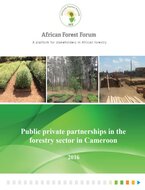Cameroon’s land area covers about 46 million ha with 16.8 million ha as dense tropical forests and 29.8 million ha as degraded humid forests. The almost double proportion of degraded forests to dense forests is a good indication of human induced disturbance of the forest ecosystem in Cameroon. History has its role to play in the current state of Cameroonian forests but the contemporary influences are governed by the legal and regulatory texts in place. Today, total surface area of Cameroon’s forests is 23 035 630 ha representing 48.73% of the national territory. The forests are classified as production and protection forests or remain unclassified. Production forests are exploited and managed under four forest management regimes, and in keeping with several management conventions, standards or multi-lateral environmental agreements (MEAs) such as the UN Forest Principles/Agenda 21 and also with several partnerships.
This study seeks to identify, promote promising public private partnership (PPP) models or approaches for forest compatible sustainable livelihoods development and strengthen the capacity of the industry to address both social and environmental concerns in ways that can contribute to more sustainable, equitable and effective private sector development.

